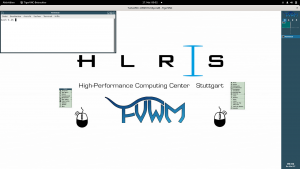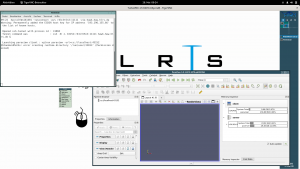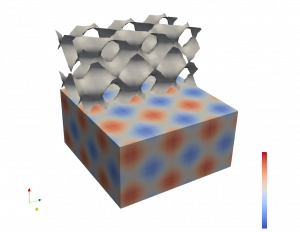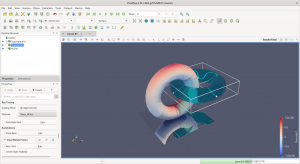- Infos im HLRS Wiki sind nicht rechtsverbindlich und ohne Gewähr -
- Information contained in the HLRS Wiki is not legally binding and HLRS is not responsible for any damages that might result from its use -
Hawk PrePostProcessing: Difference between revisions
| Line 99: | Line 99: | ||
-DCMAKE_INSTALL_PREFIX=$PV_PREFIX/paraview/${PV_VERSION}/client | -DCMAKE_INSTALL_PREFIX=$PV_PREFIX/paraview/${PV_VERSION}/client | ||
</pre> | </pre> | ||
in case you would like to use Ray Traced Rendering please install OSPRay on your local machine and add the following two lines to the cmake command | |||
<pre> | |||
-DPARAVIEW_ENABLE_RAYTRACING=ON \ | |||
-Dospray_DIR=<path_to_ospray_installation>/lib/cmake/ospray-2.9.0 | |||
<pre> | |||
in which <code><path_to_ospray_installation></code> has to be replaced with the path to your local OSPRay installation. At HLRS we use the precompiled binary distributions available at [https://www.ospray.org/downloads.html]. After successful configuration build and install with | |||
<pre> | <pre> | ||
make -j 20 | make -j 20 | ||
Revision as of 12:01, 15 September 2022
For pre- and post-processing purposes with large memory requirements multi user smp nodes are available. These nodes are reachable via the smp queue. Please see the node types, examples and smp sections of the batch system documentation.
Remote Visualization
Since Hawk is not equipped with Graphic Hardware, the visualization has to be done remotely either in the Vulcan cluster or in locally installed clients.
Paraview
ParaView server is installed on Hawk with mpi support for parallel execution and rendering on the compute nodes. The installation is available via the module environment.
module load paraview/server[/<version>]
To enable parallel data processing and rendering on the CPU Paraview is installed with the mesa llvm gallium pipe. This means the Qt based graphical user interface (GUI) is not available i.e. the paraview command and the ParaView client. Scripted usage is possible via pvbatch. For interactive parallel post-processing and visualization pvserver has to be used.
Client-Server Execution using the Vulcan Cluster
Graphical ParaView clients matching the server versions on Hawk are installed on the Vulcan cluster. For efficient connection we recommend to use the vis_via_vnc.sh script available via the VirtualGL module on Vulcan. More information can be found at Graphic_Environment
Setting up the VNC desktop session
ssh vulcan.hww.hlrs.de module load tools/VirtualGL vis_via_vnc.sh
Please note that this will reserve a standard visualization node in Vulcan for one hour. Additional nodes with other graphic hardware are available and the reservation time can of course be increased. for a full list of options please use
vis_via_vnc.sh --help
To connect to the vnc session on the visualization node from your local client computer use one of the methodologies issued by the vis_via_vnc.sh script. The recommended way is to use a TigerVNC viewer or TurboVNC viewer with the -via option.
vncviewer -via <user_name>@cl5fr2.hww.hlrs.de <node_name>:<display_number>
After successful connection you should be logged in to a remote Xvnc desktop session.
Setting up pvserver
In parallel a regular compute node job has to be requested on Hawk. E.g.
qsub -l select=2:node_type=rome:mpiprocs=128,walltime=01:00:00 -I
Once logged in to the interactive compute node job load the paraview/server module and launch pvserver.
module load paraview/server[/<version>] mpirun -n 256 pvserver
If pvserver was launched successfully it should issue the connection details for the paraview client. E.g.:
s32979 r41c2t6n4 203$ mpirun -n 256 pvserver Waiting for client... Connection URL: cs://r41c2t6n4:11111 Accepting connection(s): r41c2t6n4:11111
Connection of ParaView Client and Server via pvconnect
To connect a graphical ParaView client executed within the vnc session on Vulcan with the server running on the Hawk compute nodes a ssh tunnel has to be established. For convenience we provide in the client installation the pvconnect script. Please note that the script assumes that public / provate key, ssh connection without password is possible between Vulcan and Hawk.
The script takes two arguments.
-pvsis the combination<servername>:<portnumber>isseued during pvserver startup underAccepting connection(s):.-viais the hostname of the machine over which to tunnel onto the pv server host.
Usually this is hawk.hww.hlrs.de. So taking the example from the server startup given above, to launch a ParaView client within a VNC desktop session and directly connect it to a running server on Hawk compute nodes use:
module load tools/paraview pvconnect -pvs r41c2t6n4:11111 -via hawk.hww.hlrs.de
The connection and memory load on the server can be checked within the client by activating the Memory Inspector via the View menu within the ParaView client.
Client-Server Execution using a local client
It is also possible to connect a locally running ParaView to a server running on Hawk. For that we recommend to compile a matching ParaView client on your local machine.
ParaView Installation
So either check out the correct ParaView sources version from the ParaView git repositories or download the source tar archive we provide in the ParaView intallation directory on Hawk. With the ParaView module loaded the sources can be found in
$PARAVIEW_SRC
On your local machine, extract the archive, define your installation location
export PV_PREFIX=<path_to_installation_directory>
Setup your build directory
cd ParaView/
export PV_VERSION=`git describe --tags`
echo $PV_VERSION
cd ..
mkdir ParaView_${PV_VERSION}_build_client
cd ParaView_${PV_VERSION}_build_client
Configure the ParaView installation process with cmake
cmake ../ParaView \
-DCMAKE_BUILD_TYPE=Release \
-DCMAKE_CXX_COMPILER=c++ \
-DCMAKE_C_COMPILER=gcc \
-DCMAKE_Fortran_COMPILER=gfortran \
-DPARAVIEW_USE_PYTHON=ON \
-DPARAVIEW_INSTALL_DEVELOPMENT_FILES=ON \
-DPARAVIEW_BUILD_SHARED_LIBS=ON \
-DBUILD_TESTING=OFF \
-DCMAKE_INSTALL_PREFIX=$PV_PREFIX/paraview/${PV_VERSION}/client
in case you would like to use Ray Traced Rendering please install OSPRay on your local machine and add the following two lines to the cmake command
-DPARAVIEW_ENABLE_RAYTRACING=ON \
-Dospray_DIR=<path_to_ospray_installation>/lib/cmake/ospray-2.9.0
<pre>
in which <code><path_to_ospray_installation></code> has to be replaced with the path to your local OSPRay installation. At HLRS we use the precompiled binary distributions available at [https://www.ospray.org/downloads.html]. After successful configuration build and install with
<pre>
make -j 20
make install
And finally extend your PATH and LD_LIBRARY_PATH environment variables:
export PATH=$PV_PREFIX/paraview/${PV_VERSION}/client/bin:$PATH
export LD_LIBRARY_PATH=$PV_PREFIX/paraview/${PV_VERSION}/client/lib64:$LD_LIBRARY_PATH
The newly installed client should now be executable.
Using pvconnect locally
On the Vulcan cluster we provide the pvconnect script to set up a ssh tunnel, launch a ParaView client and directly connect it to a pvserver running on Hawk. The script is also usable from a local client if the nettest utility is available. Simply copy the code below into a local file and connect to a running pvserver as described above.
#!/bin/bash
###############################################################################
# pvconnect
# --------------
# The script opens a ssh-tunnel to a given compute node via a mom node and
# launches a paraview client with the correct -url option
###############################################################################
usage()
{
echo
echo "USAGE: $0"
echo " -pvs pvserver[:port] -via host"
echo
echo "-pvs = ParaView server to connect to. Either the hostname alone or "
echo " hostname:port can be given. The hostname:port combination is"
echo " normally returned the pvserver by the comment:"
echo " Accepting connection(s): hostname:port"
echo " if no port is given the default port 11111 is used"
echo "-via = Hostname via which to connect to the server. If the server was"
echo " launched by aprun this should be the name of the mom node"
echo " on which the aprun was executed."
echo
exit $1
}
#
if [ $# -eq 0 ]; then
usage 0
fi
#
port=`nettest -findport`
#
# -----------------------------------------------------------------------------
# Parse Arguments -------------------------------------------------------------
while [ $# -gt 0 ]
do
case "$1" in
-pvs*) acc_con=$2; shift ;;
-via*) VIA=$2; shift ;;
-help*) usage 0;;
--help*) usage 0;;
*) break ;;
esac
shift
done
#
if [ -z $acc_con ]; then
echo "!!!!!!!!!!!!!!!!!!!!!!!!!!!!!!!!!!!!!!!!!!!!!"
echo "!! Argument for ParaView server is missing !!"
echo "!! Please specify the -pvs option !!"
echo "!!!!!!!!!!!!!!!!!!!!!!!!!!!!!!!!!!!!!!!!!!!!!"
exit 1
fi
#
if [ -z $VIA ]; then
echo "!!!!!!!!!!!!!!!!!!!!!!!!!!!!!!!!!!!!!!!!!!!!!!!!!!!"
echo "!! Found no host to connect through in arguments !!"
echo "!! Please specify the -via option !!"
echo "!!!!!!!!!!!!!!!!!!!!!!!!!!!!!!!!!!!!!!!!!!!!!!!!!!!"
exit 1
fi
#
# -----------------------------------------------------------------------------
# Get target and port ---------------------------------------------------------
TARGET=`echo $acc_con | cut -d: -f1`
PVP=`echo $acc_con | cut -d: -f2`
#
if [ -z $PVP ]; then
PVP=11111
echo " "
echo " Found no ParaView server port in arguments"
echo " Using the default one: 11111"
fi
#
# -----------------------------------------------------------------------------
# Open tunnel -----------------------------------------------------------------
ssh -N -L $port:$TARGET:$PVP $VIA &
sshpid=$!
#
sleep 10
#
echo " "
echo " Opened ssh-tunnel with process id : ${sshpid}"
echo " Tunnel command was : ssh -N -L $port:$TARGET:$PVP $VIA &"
#
# -----------------------------------------------------------------------------
# Launch paraview client ------------------------------------------------------
echo " "
echo " Launching paraview client : vglrun paraview -url=cs://localhost:$port"
paraview -url=cs://localhost:$port
#
kill ${sshpid}
#
Usage examples
In this section small usage examples are documented
XDMF
Since ParaView can not load HDF5 files directly due to missing possibility to annotate topological information in a standardized way one has to provide an XDMF header file to explain to ParaView the purpose of the datasets contained within an HDF5 file.
With the following python script a 3D dataset is created by means of h5py and written to file.
import h5py
import numpy as np
a = np.arange(8000,dtype=np.float64).reshape(20, 20, 20)
for i in range(a.shape[0]):
for j in range(a.shape[1]):
for k in range(a.shape[2]):
a[i][j][k] = np.sin(i)+np.sin(j)+np.sin(k)
h5f = h5py.File('data.h5', 'w')
h5f.create_dataset('dataset_3D', data=a)
h5f.close()
The corresponding topological information, that the contained dataset represent the node data of a 3D uniform Cartesian grid with origin [0,0,0] and spacing of 1.0 and 20 grid points in each dimension can be specified with the following XDMF header.
<?xml version="1.0" encoding="utf-8"?>
<Xdmf xmlns:xi="http://www.w3.org/2001/XInclude" Version="3.0">
<Domain>
<Grid Name="Grid">
<Geometry Origin="" Type="ORIGIN_DXDYDZ">
<DataItem DataType="Float" Dimensions="3" Format="XML" Precision="8">0 0 0</DataItem>
<DataItem DataType="Float" Dimensions="3" Format="XML" Precision="8">1 1 1</DataItem>
</Geometry>
<Topology Dimensions="20 20 20" Type="3DCoRectMesh"/>
<Attribute Center="Node" Name="Data" Type="Scalar">
<DataItem DataType="Float" Dimensions="20 20 20" Format="HDF">data.h5:/dataset_3D</DataItem>
</Attribute>
</Grid>
</Domain>
</Xdmf>
OSPRay Rendering
From ParaView Version 5.10 onwards the OSPRay ray tracing renderer is compiled into client and server. With the ParaView module loaded a material database provided by [1] under creative commons (CC0) copyright can be found under
$PARAVIEW_MAT
Once the ospray_mats.json file is loaded via Load Path Tracer Materials... from the File menu, a Material can be selected in the Ray Tracing section of the Properties Panel. The material is displayed, i.e. rendered in the 3D scene once the Enable Ray Tracing check box in the Ray Traced rendering> section of the Properties Panel is activated and OSPRay pathtracer is selected from the Back End dropdown menu.



